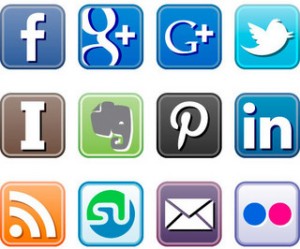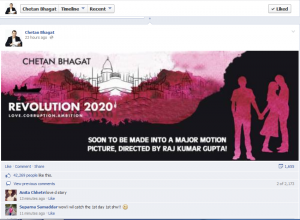
-Percy Parry
Traditional publishers have right from the beginning decided whether or not to publish a book based on the platform that the author’s book can generate in the market. And many aurthors think that approaching a traditional publisher is more beneficial because the traditional publishers have a better idea of the type of market the book will do best in.
The potency of your marketing platform does determine your success rate, but this doesn’t mean that only traditional publishers have the secret recipe to success. There are many independent publishers out there who are doing exceptionally well with little or no help at all from traditional publishers. What’s their secret to success you ask? Social Media!
“Social media allows us to behave in ways that we are hardwired for in the first place – as humans. We can get frank recommendations from other humans instead of from faceless companies,” says Francois Gossieaux, co-founder of Human 1.0, a management consultancy and Co-Author of The Hyper-Social Organization. Wrap your mind around this one, for there is no circumstance under which thousands of fans and followers are a bad thing.
As Brian E. Boyd Sr. says, “Social media takes time and careful, strategic thought. It doesn’t happen by accident.” You have to start building your potential market at the very beginning and not just after you’re done writing your book. Because the platform will take at the least 9 months to develop, giving you a better exposure to prospective fans. Ideally you should start building a platform even before you write a book.
In an article on Mediashift on ‘10 Social Media Tips for Authors’, Guy Kawasaki writes, “There are five social-media services to choose from. You need not use them all, but each serves a different purpose. I call this the five ‘P’s of social media: Facebook is for people — people who you went to high school or college with and your family. Twitter is for perceptions — perceptions such as ‘I feel an earthquake and I’m in Chile.’ Google+ is for passions — passions such as photography that you cannot share with your Facebook people. Pinterest is for pinning — pinning pictures with little interaction. LinkedIn is for pimping — as in making business connections or finding a job. You can use each of these to build a platform, but your relationships on them are apt to differ.’
Once you’ve created an account on most of these sites, the next issue you need to focus on is creating a good profile. Remember your profile is basically a medium that advertises you to the rest of the world. So it needs to portray you as a fitting, trustworthy and likable person. First make sure the picture that you choose to upload as your profile picture is a high definition picture of your face and not your spouse, car or pets. Secondly don’t forget to feed in your personal details in the little text boxes that have been provided for this purpose This will help your potential fans know you better.
 Once you’ve done this, all you need to now do is keep your profile page busy. Your profile is the page that advertises you, and you have to make sure it makes you stand out from among a million other such profiles. Social websites are busy sites with hundreds of pictures and posts pouring in every second. As such people don’t notice posts that contain tiny images or simple text. In order to make your post visible it’s best to use pictures that are at least 400 to 500 pixels wide or maybe even a video from YouTube. Don’t forget to respond to the comments that your post generates. Remember you are not delivering a sermon, but a post which is more of a conversation. If however you are not getting any “likes” or comments, then you must be doing something wrong. Make the posts more interesting, add a caption to each picture, you can even describe what you were doing or why you clicked the picture in a few lines. Make sure you don’t sound pompous. Nobody likes a snob! Be friendly and humble in what you say in your posts. Or you will generate haters in a time frame that’s half as much as the time you took to create you platform. Be warned!
Once you’ve done this, all you need to now do is keep your profile page busy. Your profile is the page that advertises you, and you have to make sure it makes you stand out from among a million other such profiles. Social websites are busy sites with hundreds of pictures and posts pouring in every second. As such people don’t notice posts that contain tiny images or simple text. In order to make your post visible it’s best to use pictures that are at least 400 to 500 pixels wide or maybe even a video from YouTube. Don’t forget to respond to the comments that your post generates. Remember you are not delivering a sermon, but a post which is more of a conversation. If however you are not getting any “likes” or comments, then you must be doing something wrong. Make the posts more interesting, add a caption to each picture, you can even describe what you were doing or why you clicked the picture in a few lines. Make sure you don’t sound pompous. Nobody likes a snob! Be friendly and humble in what you say in your posts. Or you will generate haters in a time frame that’s half as much as the time you took to create you platform. Be warned!
It is never guaranteed that your target audience has read or even seen your posts. It is advisable to thus re-post your matter maybe every 12 hours. Assuming that the post will generate 12000 fans when it is first published is pretty much naive. NDTV doesn’t run it’s headline once a day, assuming that it’s viewers will see it the first time it flashes on screen or maybe they’ll record it and watch it later. Publishing your post and pictures every twelve hours will help you reach your audience who were then asleep but are now awake.

And last but not the least, you don’t have to sit down and carefully plan every post and re-post. Just be spontaneous! If you have a picture about your personal life or a picture that is quite inspirational or funny, upload it! Your fans will in some way or the other find their way to you. Yes, it will take some time but it WILL happen. Don’t forget to be yourself. You don’t have to sound all professional and snooty. What you post is a reflection of what you are. This is more than enough to attract fans who will love you and your work for what it truly is. There is little right or wrong in social networking, even what I say here may or may not work out. But then again it’s all about what really works for you and what doesn’t. So go ahead, get started and explore the world of social media. You’ll figure it all out along the way.
Percy Parry interns with CinnamonTeal Publishing